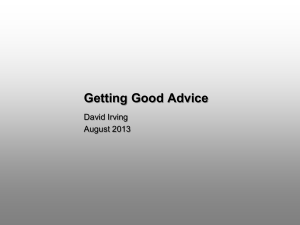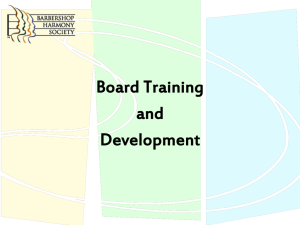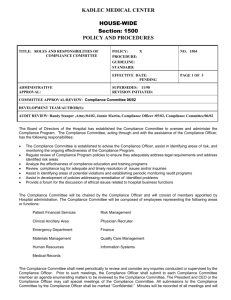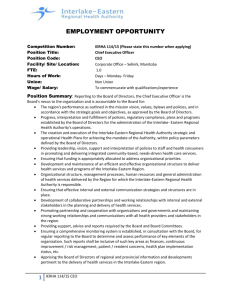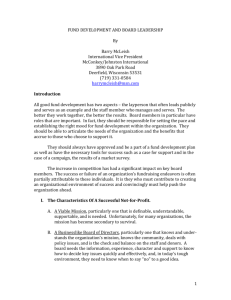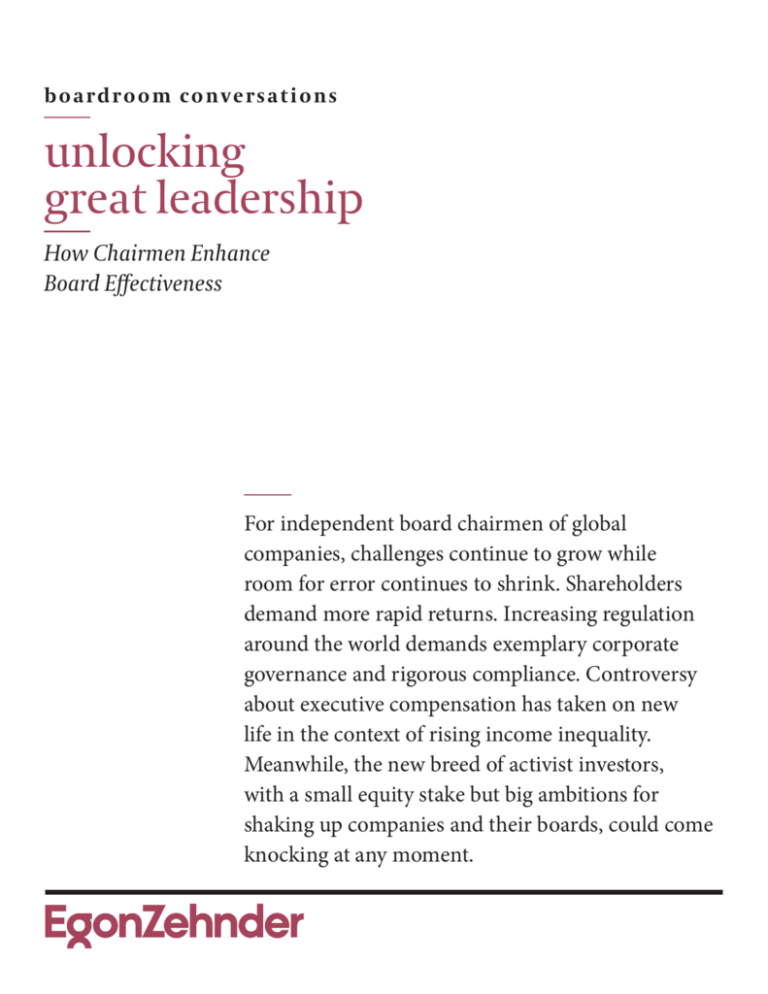
b o a r d r o o m c o nv e r s a t i o n s
unlocking
great leadership
How Chairmen Enhance
Board Effectiveness
For independent board chairmen of global
companies, challenges continue to grow while
room for error continues to shrink. Shareholders
demand more rapid returns. Increasing regulation
around the world demands exemplary corporate
governance and rigorous compliance. Controversy
about executive compensation has taken on new
life in the context of rising income inequality.
Meanwhile, the new breed of activist investors,
with a small equity stake but big ambitions for
shaking up companies and their boards, could come
knocking at any moment.
b o a r d r o o m c o nv e r s a t i o n s
To understand how today’s independent chairmen are meeting these and many other challenges,
we interviewed chairmen and independent directors from several leading global companies where
the chairman and CEO roles are split. As these in-depth conversations and our long experience of
working with boards confirm, no one answer exists for any of these challenges. However, the chances
of arriving at the right answer in any given instance are greatly increased when the board’s leader
The new breed of activist investors
could come knocking at any moment.
focuses on improving the group’s effectiveness. That means adopting best practices in the board’s
traditional “hard” responsibilities like risk oversight and succession planning, as well as attending
to the “soft” side — the dynamics, culture and values, which are essential for harnessing the full
potential of all members of the board. In these key areas of responsibility, independent chairs and
directors recommended some specific actions that boards can take at a time when enhancing board
effectiveness is more critical than ever.
Regularly Surface Risk
The independent chairs and directors we interviewed believe that the range of risks the board
ultimately must oversee continues to expand. Financial, operational and reputational risks have been
joined by cybersecurity and sustainability risks, which could pose existential threats. In addition, the
rise of digital and social media poses strategic risks to companies that fail to pay attention to these
powerful means of communication. Losing the war for talent presents another major risk in a world
where people often are a company’s most powerful competitive advantage. Similarly, many directors
see innovation — in products, services and business models — as an issue that cannot be neglected if
the company is to avoid becoming a casualty of disruptive innovation.
Some of these risks may be poorly understood. “Many boards are not fully abreast of the advances in
digital or cyber media,” says the chairman of a U.S. consumer durables company. “They must acquire
expertise in areas like these or invite experts into the boardroom.”
With distance and time becoming less relevant due to the Internet and social media, companies and
their boards must function in a world where instantaneous response is becoming the norm. “This puts
huge pressure on boards,” says the chairman of a global oil exploration company, “as sometimes they
have to address issues in China or Africa which they don’t fully understand or don’t have the time to
understand.”
Most chairmen we spoke to agree that boards should have in place reliable mechanisms for surfacing
and regularly discussing risk, as well as plans to manage and mitigate it. This means not just
making sure risk is on the meeting agenda but also finding ways to elicit candid assessments from
management, who may be reluctant to bring up issues which may reflect poorly on their performance.
2
b o a r d r o o m c o nv e r s a t i o n s
“At each board meeting, I ask the CEO to articulate clearly the top three things that are going right
and three that are not,” says the chair of an Asian multinational. “In one instance, innovation turned
out to be an area which was not attracting the desired focus, and the CEO had been dismissive about it
during past discussions around the failure of newly launched products.”
In the absence of mechanisms designed to ensure comprehensive and candid discussions of such
issues, risks can become reality, turning risk management into crisis management. “I use management
interaction to improve my understanding of what is going on in the bank,” says an experienced
European chairman. “I do not rely only on the ‘tone from the top’ but also look for feedback and
insights from the auditor, the risk officer and the CFO.”
Practice Rigorous Succession Planning
CEO succession planning remains a central responsibility for boards, and many directors see
this as their most important duty. However, as some of our interviewees observed, it can present
challenges (see Figure 1). “Planning orderly succession without attracting media attention is
increasingly difficult,” says the chair of a global insurance company, “and it must be managed with
great sensitivity.” Further, the board must address both long-term succession in preparation for a
Succession planning is unequivocally the
board’s responsibility and should be driven
by the independent chairman, not the CEO.
CEO’s planned retirement and emergency succession necessitated by an unplanned CEO departure.
Boards often have a contingency plan for emergency succession, but because longer-term succession
planning seems less urgent, they sometimes do not pay it sufficient attention. That is not the case at
the global insurance company: “Succession planning is discussed at every other meeting of the board,”
says the chair, “and information is shared transparently on the performance of possible successors.”
Succession planning is unequivocally the board’s responsibility and should be driven by the
independent chairman, not the CEO. A comprehensive best-practices approach includes three
essential steps:
• D
evelop the CEO specification: The specifications for the next CEO should be developed through
interviews with key stakeholders, including all the members of the board, and a thorough
understanding of the company’s likely strategy and business challenges at the projected time of the
CEO transition.
• A
ssess internal candidates: With the board aligned around the desirable CEO profile, a succession
committee and its advisors then can assess internal candidates against those specifications. Tailored
development plans should be prepared for each contender to maximize his or her chance of
becoming a serious candidate.
3
b o a r d r o o m c o nv e r s a t i o n s
• A
ssess potential external candidates: The board and its advisors also should develop an external
market map of leading potential CEO talent and evaluate it against the same CEO specifications
used to assess internal talent. This benchmarking exercise enables the board to determine 1) if
an ideal candidate even exists, 2) where internal candidates fall short and 3) whether an internal
candidate is as good as, or superior to, the external talent.
Figure 1
Why Making a Good CEO Selection Is So Hard
Issue
Focus on needs of
future strategy
Significant business
impact of CEO
appointment
Skills required
vary by situation
Unique demands of
CEO role
Impact CEO role
specification needs
to be tailored to
the future business
context
High stakes, complex
decision making and
communications
Strong performance
in one company
may not predict
similar performance
in another
Strong performance
in senior roles may
not predict
performance
as a CEO
Process Implication
Dedicate significant
board attention to
CEO succession
(short and long term)
Ensure rigorous
assessment and benchmarking
of internal and
external candidates
Conscientious boards bring a similar rigor to board succession planning. “No independent directors
can be appointed to our board unless they have been met by all our members,” says the chairman of a
multinational pharmaceutical company. “Retirement and renewal dates are published well in advance,
and nominations are discussed openly.”
What do the best boards look for in a potential colleague? An experienced independent director who
has served on boards across three continents says, “We look for unquestioned honesty and integrity; a
proven track record of creating value for shareholders; time available to undertake the responsibilities;
an ability to apply strategic thought to matters at issue; a preparedness to question, challenge and
critique; the determination to stay independent; and a willingness to understand and commit to the
highest standards of governance.”
4
b o a r d r o o m c o nv e r s a t i o n s
In summary, the chairmen and independent directors we spoke with want to make sure that when
it comes to CEO and board succession planning, their most important decisions also are their best
decisions. In both cases, this means not only being able to assess candidates’ experience (education,
work history and accomplishments) and performance (demonstrated skills, abilities and results) but
also their personality, style and potential. Candidates may have enviable experience and an admirable
track record, but the ultimate question is how well they will perform in the future — as CEO or as a
colleague on the board. Boards which practice real rigor in succession planning are able to answer
that question and unlock great leadership.
Leverage the Full Benefits of Good Governance
A variety of forces is bringing uniformity to governance practices around the world: increased scrutiny
by regulators, higher compliance requirements, the demands of institutional investors and the
desire of companies everywhere to make themselves more attractive to investors. In our work with
boards of leading global companies, we find a widespread and deep commitment to good corporate
governance. Many boards embrace the challenges of good governance and seek to adhere to the
highest standards, and the individual board members we spoke with are motivated by a desire to find
the best way to fulfill their responsibilities.
The structure and functioning of board
committees are critical for good governance.
Good governance, they agree, begins with a clear understanding that the board is there to oversee
the company, not to run it. “The role of the board is not to drive performance or make operational
decisions,” says one chairman, “but to hire the right CEO and then empower that person to deliver
results.” By the same token, says the chairman, the CEO is expected to be forthright and open with the
board: “The best way for the CEO to engage the board is by sharing relevant information well in advance.
It would be unacceptable to be given information about a decision after it is too late to say no.”
Many of our interviewees also agree that the structure and functioning of board committees are
critical for good governance. In fact, says the chair of a diversified multinational listed in several
countries, “The quality of committee work is more meaningful than the full board meeting. Two-thirds
of the total time should be spent in committees and one-third in meetings of the full board.” Adds
another, “The chair’s role is to encourage the committees to have candid, substantive discussions and
synthesize their conclusions for the full board.” With well-structured, high-functioning committees
and a clear understanding of roles, the board then can set clear ground rules designed to bring
transparency to matters which people generally do not find easy to talk about: CEO succession,
independent director and chairman tenure, and board effectiveness.
5
b o a r d r o o m c o nv e r s a t i o n s
Prepare to Engage in More Intense Strategy Discussions
Because everything emanates from corporate strategy, our interviewees broadly agree that
involvement in strategy is a major responsibility for boards. Directors can add value by providing a
dispassionate perspective and often long experience in a wide variety of situations. This contrasts with
the executives who may be unable to see the discontinuities or inadequacies of a strategy because they
are too close to the business. With a clear view of the company’s long-term strategy, the board also can
determine how its composition should evolve in the coming years.
The chairman must guide the board through
high-profile, often highly emotional conflicts.
Increasingly, however, strategy and board composition are being challenged in the short term by
activist investors who take a small equity stake and then very publicly challenge management and the
board. Often the activist proposes an alternative strategy — typically today, spin-offs or divestments
of some of the company’s businesses. Activists also may demand changes in the board and offer
candidates to replace directors the activists regard as being underperformers or lacking in relevant
experience or knowledge. If the board refuses, the activist may initiate a bruising proxy fight. In these
high-profile, often highly emotional conflicts, the independent chairman must guide the board to the
response that ultimately is best for shareholders — whether that response means adopting some of the
activist’s suggestions, compromising on changes to the board or opposing the activist at every turn.
The board’s role in strategy also has been magnified recently by the sharp increase in merger and
acquisition activity. According to Thomson Reuters, 40,298 transactions — worth nearly $3.5 trillion
— were announced worldwide in 2014, the biggest increase in deals since 2007. A major move, like
acquiring a competitor or a complementary business — or deciding how to respond if the company
has become an acquisition target — requires independent directors who have done their homework
and a chairman who can orchestrate a thorough discussion of the implications of any of these
possibilities.
Cultivate a Culture of Trust and Enable Productive
Group Dynamics
Much of a board’s effectiveness results from its culture and dynamics. No one is better positioned than
the independent chairman to set the tone for both. Ideally, our interviewees agree, the chairman will
establish an atmosphere of trust and openness, elicit conversations that are candid and constructive,
and encourage diversity of ideas combined with uniform dedication to the best interests of the
company.
6
b o a r d r o o m c o nv e r s a t i o n s
Interviewees were highly specific about ways chairs can promote a healthy atmosphere and
productive interactions. Prior to meetings, the chairman should speak with independent directors
and management to get a “feel” for what is on their mind and set the agenda accordingly. However,
as one director points out, “It is troublesome when information is shared selectively with some board
members by the chairman but reaches other directors through a third party.” During meetings,
the chairman should have the wisdom and judgment to enable effective decision making without
dominating a discussion or being the first to offer a view. “The chairman must be attuned to being fair,
objective and balanced,” is a typical observation among interviewees. “The chairman is a facilitator
among equals,” says a retired chair of a publicly listed global enterprise. “If the chairman dominates,
then the agenda of the meeting gets hijacked.” When there is disagreement around the table and
an issue must be resolved, the chairman should strive to create genuine alignment rather than force
grudging consensus.
Ultimately, says an independent director, the chairman should create an environment which
“encourages participation and allows board members to derive meaning, inspiration and satisfaction
from their work.”
Conclusion: It’s about Maintaining Balance
Through these in-depth conversations with independent chairmen and directors, there ran a common
thread: Ensuring board effectiveness is about balance. Effective oversight requires the ability to
balance short-term returns with the long-term health of the company. Effective board composition
entails the right balance of competencies, knowledge, diversity and experience in sync with the
company’s strategy. For their part, independent chairmen must maintain balance in the way they
conduct the board’s business: encouraging discussions which are candid but constructive and
enabling openness but moving issues toward resolution.
Ensuring board effectiveness is about balance.
The splitting of the chairman and CEO roles is itself part of the quest for balance; in this case, it’s
between oversight and operational responsibilities. The independent chairman’s work with the CEO,
if it is to be productive, also requires a careful equilibrium. The relationship should be collegial, but it
also should remain at arm’s length: independent but not oppositional.
Balance in all of these senses is not an achieved state but a process which requires conscious attention
and considered action. As our conversations with these independent chairmen and directors confirm,
thoughtful board members and chairmen work continually to maintain that balance.
7
b o a r d r o o m c o nv e r s a t i o n s
Authors
Sonny Iqbal
New Delhi
sonny.iqbal @egonzehnder.com
+91 124 46 38 000
Sonny Iqbal, based in New Delhi, is a trusted advisor to boards and senior leadership
teams and brings comprehensive experience across multiple industries and sectors.
David Kidd
London
david.kidd@egonzehnder.com
+44 20 7943 1909
David Kidd, based in London, specializes in board assignments and CEO succession,
mainly in the resources and industrial sectors.
Our Thanks to Our Contributors
We are very grateful to the chairmen and independent directors who shared their thoughts and
experiences with us and contributed to the findings of this article.
Our Board Consulting Practice
Egon Zehnder’s Board Consulting Practice works closely with the world’s most respected and
highest-performing boards, and we maintain close ties to outstanding leaders in multiple industries
in every geography.
As your board’s trusted advisors, we connect you to the most advanced insights into board
effectiveness, help you craft creative solutions and strategies grounded in deep knowledge of best
practices, and bring you ready global access to top directors. We help your board maximize its
strategic value to your company and its shareholders.
Further, the Egon Zehnder consultants supporting your board link you to the expertise and market
reach of all the consultants across our global network. This is not a mere promise, it is a core value of
our firm.
8
Egon Zehnder is the world’s leading privately held executive search and
talent management consultancy with more than 400 consultants in
69 offices across 41 countries. The firm provides senior-level executive
search, board search and advisory, CEO succession and family business
advisory, as well as leadership assessment and development to the
world’s most respected organizations. Egon Zehnder’s clients range
from the largest corporations to emerging growth companies, family
and private-equity controlled entities, government and regulatory
bodies, and major educational and cultural organizations. For more
information: www.egonzehnder.com.
© 2015 Egon Zehnder International, Inc.
All rights reserved.
No part of this publication may be reproduced, stored in a retrieval
system or transmitted in any form or by any means ­— electronic,
mechanical, photocopying, recording or otherwise ­— without the prior
permission of Egon Zehnder.
Amsterdam
Athens
Atlanta
Bangalore
Barcelona
Beijing
Berlin
Bogotá
Boston
Bratislava
Brussels
Budapest
Buenos Aires
Calgary
Chicago
Copenhagen
Dallas
Dubai
Düsseldorf
Frankfurt
Geneva
Hamburg
Helsinki
Hong Kong
Houston
Istanbul
Jakarta
Jeddah
Johannesburg
Kuala Lumpur
Lisbon
London
Los Angeles
Luxembourg
Lyon
Madrid
Malmö
Melbourne
Mexico
Miami
Milan
Montreal
Moscow
Mumbai
Munich
New Delhi
New York
Oslo
Palo Alto
Paris
Prague
Rio de Janeiro
Rome
San Francisco
Santiago
São Paulo
Seoul
Shanghai
Singapore
Stockholm
Stuttgart
Sydney
Tel Aviv
Tokyo
Toronto
Vienna
Warsaw
Washington,
D.C.
Zurich

